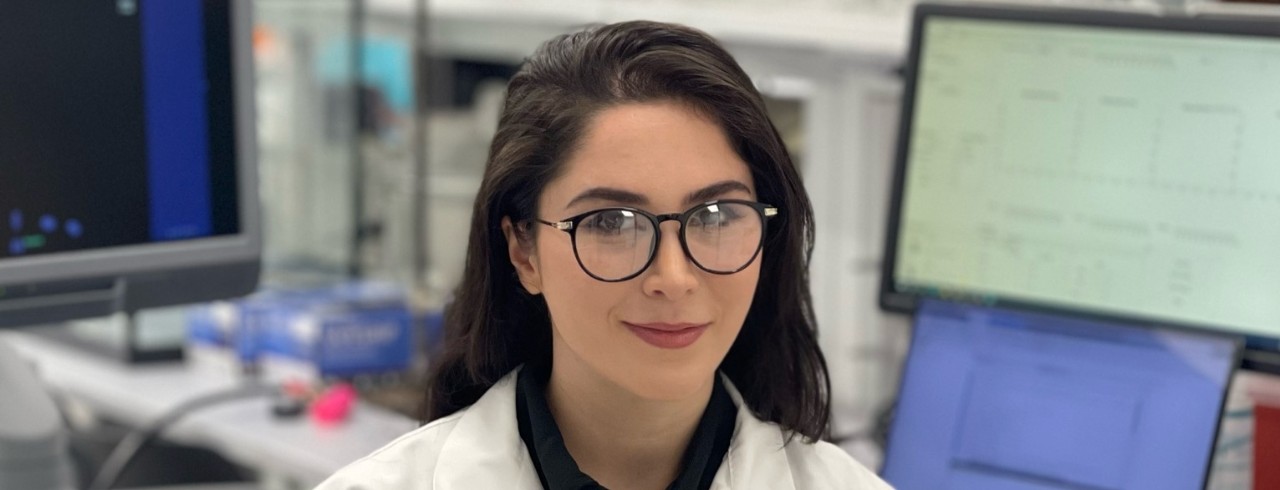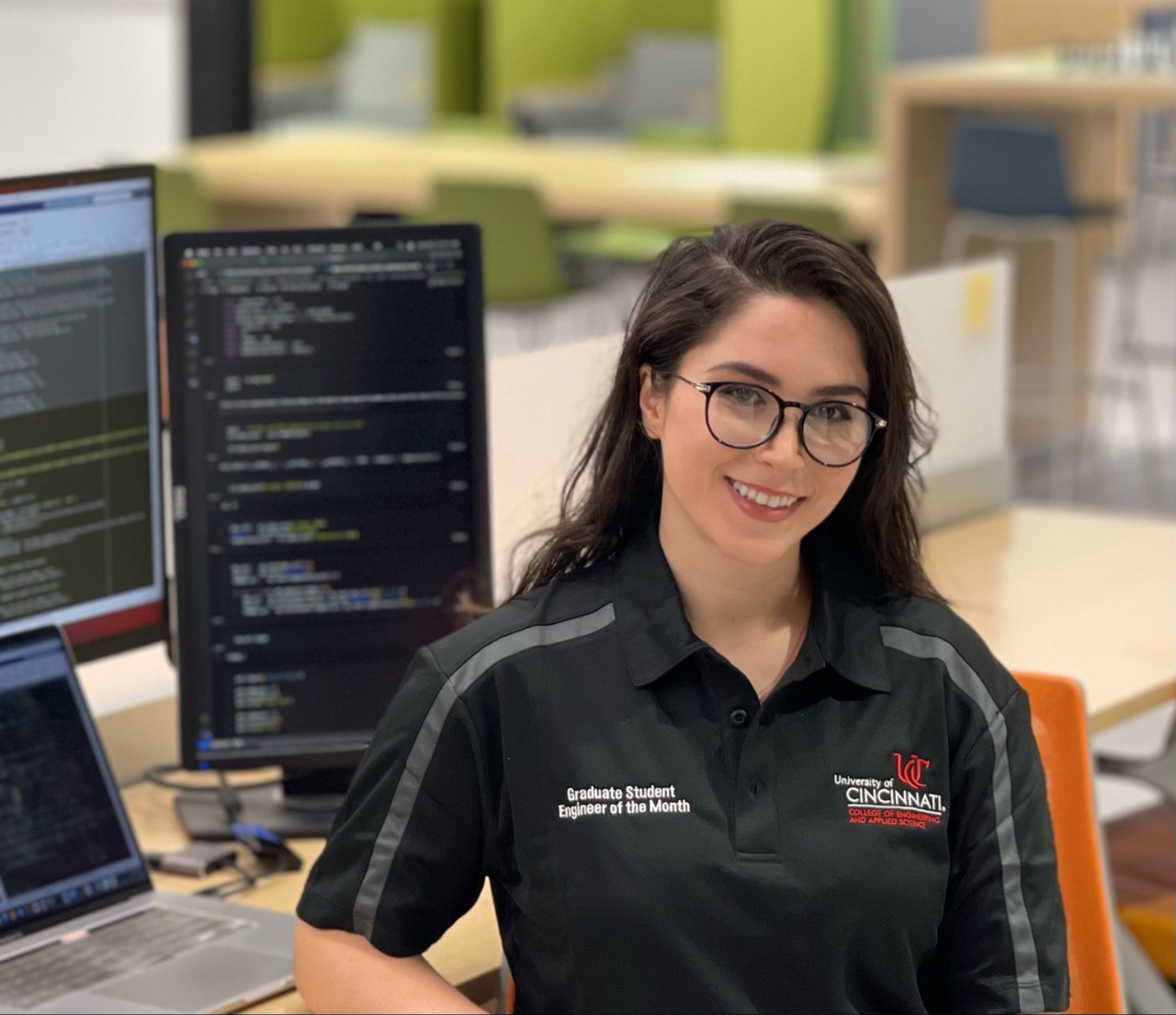
UC engineering student works to advance ultrasound technology
Elmira Ghahramani's research focuses on liver tumor ablation
Elmira Ghahramani, a biomedical engineering PhD student at the University of Cincinnati, first found an interest in medical imaging during her undergraduate studies in Tehran, Iran. Her research aims to address limitations and enhance the efficacy of ultrasound imaging, specifically as it applies to liver tumor thermal ablation. She collaborates with professionals from Cincinnati Children's Hospital and was named Graduate Student Engineer of the Month from the College of Engineering and Applied Science.
Why did you come to UC to study?
Among the graduate schools I was considering for enrollment, the University of Cincinnati stood out for its active and strong biomedical ultrasound imaging group. UC's multiple labs are actively engaged in this field, guided by renowned professors, and equipped with state-of-the-art ultrasound imaging instruments that provide an ideal setting for advanced research. The collaborative environment between health care professionals and engineering researchers, coupled with the labs' strategic location at the core of the medical campus significantly influenced my decision to select UC for my doctoral studies.
Why did you choose your field of study?

Elmira Ghahramani
Biomedical imaging offers a unique blend of technology and significant real-world applications. Through our multidisciplinary research, I have used my engineering skills to fill in some clinical gaps to help improve healthcare for patients with cancer. Furthermore, ultrasound imaging is non-invasive, safe, affordable, and widely used in medicine with broad potential, including real-time 2D/3D imaging and characterization of the mechanical properties of the tissue. This imaging modality is a pivotal tool for diagnosis, monitoring, and even treatment. Therefore, as healthcare continues to evolve, there is a growing need for professionals who can develop and refine ultrasound technologies, improving their accuracy and versatility.
Briefly describe your research work? Why does it interest you?
My Ph.D. work aims to enhance the efficacy of ultrasound imaging in the thermal ablation or removal of liver tumors. At the Biomedical Acoustics Laboratory, we do this using our innovative method, 3D ultrasound echo decorrelation imaging.
This is a computationally efficient method that spatially maps heat-induced changes in ultrasound echoes over millisecond time scales and can provide feedback on ablation progress while the tumor is being ablated to avoid over or under treatment.
We explored advanced image and signal processing methods, including real-time feedback control algorithm, temperature prediction, registration among various imaging modalities and more. Using National Institute of Health funding, we have evaluated our method ex vivo (outside the body) in bovine and human liver and in vivo (inside the body) in swine liver, as well as in the percutaneous ablation of human liver tumor. This was done in collaboration with the Department of Radiology at UC. It is quite interesting to me that by developing novel monitoring methodologies and tools, we can enhance the accuracy, precision, and safety of tumor ablation procedures while minimizing the risk to the surrounding healthy tissues.
What are some of the most impactful experiences during your time at UC?
Through my academic coursework and hands-on experience, I have gained a solid foundation in ultrasound imaging techniques, signal and image processing, and software development. I have also had the privilege of working alongside esteemed researchers and clinicians, witnessing firsthand the challenges faced in liver thermal ablation procedures and the critical role ultrasound imaging can play in targeting and ensuring effective treatment outcomes.
What are you most proud of accomplishing?
I took the initiative to extend 3D echo decorrelation imaging to include advanced artificial intelligence techniques to improve the delineation of the ablation zone and temperature prediction for monitoring thermal ablation. For this purpose, I spent a few months earning certificates in the online machine and deep learning courses. I employed my knowledge to augment our echo decorrelation imaging technique, the result of which I presented at the recent Acoustical Society of America international conference in Chicago in May 2023, with the proceedings paper ready to be published. This work led to a new collaboration with the researchers from the Cincinnati Children's Hospital Medical Center and a postdoctoral opportunity at a strong ultrasound research laboratory at Cornell University.
What are your plans after earning your degree?
I will move to New York City to start my work as a postdoctoral researcher at Weill Medical College of Cornell University.
Outside of your research, do you have any other hobbies?
I do have a few other activities and hobbies that I enjoy outside of my professional life. I am passionate about oil painting and find it a therapeutic and creative outlet. I also love to write poetry, which I think is the most beautiful form of self-expression. I also run four or five days a week after work.
Featured image at top: Elmira Ghahramani in the lab. Photo/provided.
Related Stories
How to keep birds from flying into your windows
July 3, 2024
UC College of Arts and Sciences professor Ron Canterbury tells the Indianapolis Star that simple steps can prevent birds from strike windows around your home or business. Yahoo! News shares the story.
4 steps to craft an outstanding graduate program application
July 2, 2024
Derrya Mathis, a graduate of the pre-occupational therapy program, shares her insights and experiences on successfully applying to graduate school.
UC study: Brain organ plays key role in adult neurogenesis
July 2, 2024
The University of Cincinnati has published research in the Proceedings of the National Academy of Sciences that found the choroid plexus and cerebrospinal fluid play a key role in maintaining a pool of newly born neurons to repair the adult brain after injury.
UC’s microchip training includes innovative VR
July 2, 2024
To build a virtual microchip factory, University of Cincinnati doctoral students turned to the real one where they work. UC launched a new training program for microchip manufacturing in advance of the new fabrication plant Intel Corp. is opening in Ohio.
University-wide Qualtrics license coming soon
July 2, 2024
The new university-wide Qualtrics license will provide current UC students, faculty, and staff members access to Qualtrics software, support, and technical assistance under a centralized license.
Bridging creativity and commerce
July 1, 2024
At the University of Cincinnati’s Carl H. Lindner College of Business, Victoria Mrofchak stands out not just for her academic excellence but for her remarkable blend of creativity and business acumen. A fourth-year marketing major with a minor in management and fine arts, scholarships help Mrofchak shape her future at the intersection of art and commerce.
CCM students receive 16 award nominations from NATAS Ohio Valley Chapter
July 1, 2024
Students from the University of Cincinnati College-Conservatory of Music received 16 Student Production Award nominations from the Ohio Valley Chapter of the National Academy of Television Arts and Sciences (NATAS).
Meet UC’s Miss Ohio
July 1, 2024
UC biomedical science student Stephanie Finoti credits UC for helping to prepare her for the Miss Ohio Scholarship Pageant. She will represent Ohio in the national competition in January.
Cincinnati researchers want to know if MRIs can work better
June 28, 2024
WVXU and the Cincinnati Business Courier highlighted a new collaboration between the University of Cincinnati College of Medicine, UC Health GE HealthCare, JobsOhio, REDI Cincinnati and Cincinnati Children’s to create an MRI Research and Development Center of Excellence located on UC’s medical campus.
Free Wi-Fi, work area coming to Greater Cincinnati
June 27, 2024
St. Lawrence Park in Price Hill now has free Wi-Fi and a furnished outdoor space for community members to access digital needs. The space is part of The Nodes Project, which stands for “Neighborhoods of Design Engagement": a collaboration between UC DAAP communication designers and community entities.
